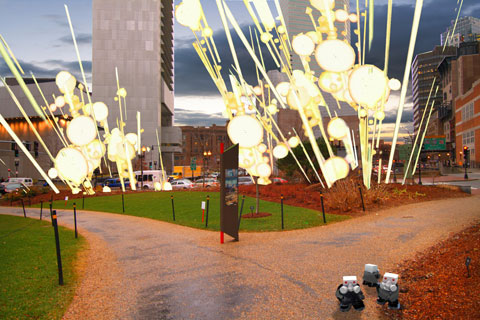
ALIENS ALONG THE ROSE KENNEDY GREENWAY At least, there will be if you know how to use your smart phone. |
It's a quiet morning along the Rose Kennedy Greenway when I meet Mark Skwarek — a shaggy-haired New Yorker in a Spider-Man T-shirt and Puma sneakers — to check out his latest project, Occupation Forces. You use your smart phone to scan the QR barcodes posted along the park (between Atlantic Avenue and Purchase Street from Summer Street to Seaport Boulevard). Then you launch the app, put the phone in camera mode, and peruse the scenery. Your phone picks up images of cartoony flying saucers firing laser beams around the neighborhood, sparks rising from the ground, craters that seem to be burned out of the park's lawn, and little blocky figures swarming over Boston.The virtual attack, a collaboration with Joseph Hocking, is a main attraction of the seventh biennial Boston Cyberarts Festival (bostoncyberarts.org/festival), which director George Fifield founded in 1999 to "exemplify the best use of cutting-edge technologies in contemporary art." But for now, the augmented reality is still buggy. Don't pan your phone too fast or the craters will slide around.
Skwarek is part of a group of techies who without permission virtually squatted in New York's Museum of Modern Art last October. Clued-in smart-phone users could see that he and John Craig Freeman had digitally transposed a swath of Mexico-Arizona borderland onto MoMA's outdoor courtyard. A difficulty at MoMA, as here in Boston, is that the GPS markers used to anchor the digital images drift around. And it's easy to lose the web connection.
An international group called Manifest.AR formed out of the MoMA project, and with the Institute of Contemporary Art's permission, it's virtually projecting works around the building (100 Northern Avenue, Boston). Smart-phone users can find John Cleater's mirrored virtual clouds. Patrick Lichty inserts Mooninite cartoons in homage to the 2007 advertising prank that prompted a terrorism scare in Boston. Will Pappenheimer floats virtual bufu toads around the museum — if you virtually lick them, the digital toads launch a hallucination of eyeballs and flowers.
"Pappenheimer's making virtual drugs," Skwarek explains. He continues, "I've been waiting for augmented reality that breaks the bonds. The laws of physics no longer apply to us. It's like, game on, man." In four to five years, he predicts that graphics as good as PlayStation3's will synch to light and weather, with tech advances funded by advertisers seeking to erect billboards in the virtual world. Right now, though, even the most groundbreaking work is clunky. Skwarek asks for patience: "This is the birth of modern-day AR that you're going through. This is like the birth of the internet."
It's true that an avant-garde technology fest needs to take ambitious risks like this. But there's too much among the 56 events of the 2011 edition that's small bore or doesn't pan out. Cyberarts needs a reboot.
The festival's sharpest work is Jim Campbell's Exploded View (Commuters) at Howard Yezerski Gallery (460 Harrison Avenue, Boston) and "Move Me," a group show curated by Heidi Kayser at Axiom (141 Green Street, Boston). Campbell's piece is a field of 1152 white LED bulbs dangling from a steel armature in the dim gallery like a field of stars. The lights act like pixels flickering rhythmically to show shadowy people walking back and forth, as if on a busy street. The end result feels simple, but how it got there registers as magic.